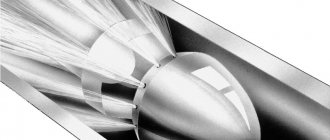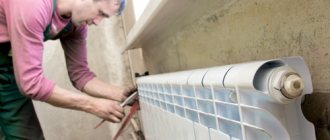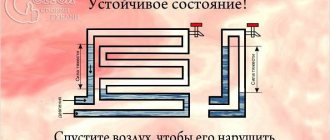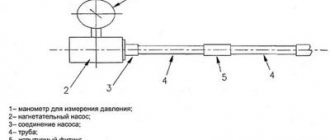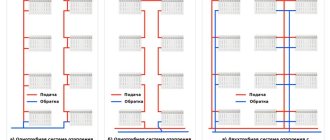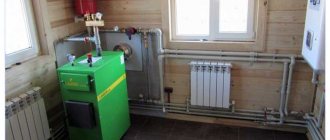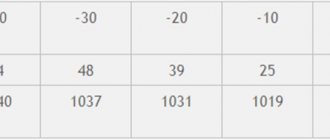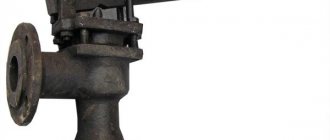SP-OM
The complex product of the SP-OM brand is used for flushing heating systems, heat exchangers, boilers and any other heat exchange equipment. Can be used in open and closed heat exchange circuits. "SP-OM" does not destroy aluminum and polymer elements of the system, as well as rubber gaskets. It has proven itself well on an industrial scale. There are various brands of SP-OM designed for specific operating conditions. Manufacturer's website - https://spomcom.ru/
SP-OM Pros
- effective removal of scale, rust and other deposits;
- wash-in-place;
- does not corrode rubber gaskets and seals;
- prevents corrosion of ferrous metals;
- may further include a corrosion inhibitor;
- Can be used with aluminum parts.
Minuses
Consultation and services of a flushing specialist may be required.
SP-OM
Metalin T is a product made on the basis of hydrochloric acid. Removes heavy lime deposits, rust products and organic matter in heating systems made of steel or non-ferrous metals. It is a non-flammable substance. After adding an alkaline neutralizer, the waste is allowed to be drained into the sewer. Packaged in concentrated form in containers from 1 to 30 liters.
Metalin T Pros
- non-flammable;
- quick cleansing.
Minuses
- after neutralization with alkali, discharge into the sewer system is allowed;
- not used for treating surfaces made of aluminum and its alloys.
Used in the treatment of pressure boilers, tubular heat exchange devices, boilers, condensers, pipelines in industry and domestic conditions. Removes various types of contaminants, in particular limestone and corrosive deposits. Ideal for washing plastic, metal and rubber pipes. Cleans carefully and does not have a negative effect on the structure of the seals. Not recommended for cleaning systems with surfaces made of aluminum and derivative alloys. Preliminary testing on treated stainless steel surfaces is also recommended.
SYNTILOR Watesup Pros
- does not affect the structure of metals;
- concentrated product;
- high efficiency even at low operating temperatures (20–35°C);
- does not damage seals and rubber gaskets;
- contains an inhibitor.
Minuses
cannot be used for products made of aluminum and derivative alloys.
Heating system cleaner SYNTILOR Watesup
Deoxyl-3
Deoxyl-3 is an acid-type product for chemical cleaning of pipelines in heating and water supply systems. It is packaged as a concentrate in 20 liter containers. The liquid is not flammable and belongs to toxicity class 3. For a greater cleaning effect, it is advisable to use the Deoxyl NO additive together with the drug. Foaming is neutralized by the Foral PG additive. The liquid is quite aggressive, so when working with it it is recommended to protect the skin and respiratory organs with protective equipment. Use strictly according to label instructions.
Deoxyl-3 Pros
- completely removes scale-corrosion deposits regardless of the design features of the equipment;
- biodegradable;
- after washing, the spent working solution can be drained into the sewer;
- The composition includes various inhibitors that prevent metal etching and the appearance of corrosion. Inhibitors not only remove deposits, but also protect the metal.
Minuses
The liquid is aggressive (work with it only with protective equipment).
Which system flushing products would you choose or would you recommend purchasing?
Deoxyl-3
75.00 % ( 3 )
Save your voting results so you don't forget!
To see the results you need to vote
Legislative regulation on heat supply cleaning
Flushing and pressure testing of heating systems is regulated by regulations and is included in the register of mandatory operations for the operation of heating structures. The regulation is enshrined in current legal acts on the filing of appeals and complaints in the event of failure of management organizations to fulfill their duties.
Decree of the Russian Government No. 354
Decree number 354 specifies the annual cleaning of home heating circuits in the form of flushing. The procedure is also carried out after the installation of communications, major repairs and routine repairs, expressed by the replacement of pipelines.
In the case of an open system, disinfection is carried out. The purpose of the treatment is to remove dirt, silt, scale and lime deposits from the inner walls of the pipes.
The operation is performed using the following available methods:
- hydraulic;
- hydropneumatic;
- chemical
Membranes and nozzles of hydraulic elevators are removed during this period. Recuperators and regenerators are cleaned mechanically or chemically. It is prohibited to use media supply lines that have not been cleaned and disinfected. After the operation, the structure is filled with water.
Decree of the State Construction Committee No. 170
Resolution of the Russian Federal Construction Authority No. 170 (current version 2021) covers issues of proper operation of the heating structure. The regulations indicate a summer inspection of shut-off valves, flushing of building blocks, and elimination of permanent and temporary blockages.
If the apartment batteries do not warm up, they undergo a hydropneumatic procedure. Section V reminds us of the annual processing of the thermal configuration after the end of the heating period, and in case of replacement of elements of open circuits, they are disinfected.
The communications are flushed with a volume of cold water that exceeds the required consumption of the hot resource at least 3-5 times, until it is completely clarified.
However, employees of management structures often carry out processing, justifying their behavior by the fact that the decree of the Federal Agency is intradepartmental and cannot be implemented. Although Art. number 2.6 talks about the preparation of housing stock for winter by its owner and local government institutions.
Watch the video: “Flushing heating systems using the hydro-pneumatic ram method.”
Decree No. 290 on flushing and cleaning heating
Order No. 290 of the Russian government provides a list of services and work that must be performed to maintain the serviceability of residential multi-story buildings.
The second chapter indicates that work is being carried out to preserve heat consumption:
- hydraulic tests of communications stability;
- flushing heating radiators, adjusting heat supply units with preliminary commissioning of furnaces;
- releasing air pockets from the structure;
- washing of networks to wash away scale-corrosion deposits;
- processing of heat exchange devices.
The Resolution does not give a clear indication of the frequency of their conduct, but makes a footnote to the order of the State Construction Committee. Timing procedures must adhere to the legislation of the country, but flushing can be carried out by decision of a meeting of apartment owners.
GOST P 56501-2015
7 facts about heating radiators.
State standard number P56501-2015 (with amendments and additions in 2021) also stipulates the conditions for processing networks. His article No. 5 talks about organizing seasonal training. Shortly before the end of the coolant supply, the contractor draws up and coordinates his actions with heating or another resource-supplying structure a plan for carrying out restoration measures - flushing, pressure testing, conservation of communications.
The contractor fulfills the conditions according to the agreed schedule, after which the acts are drawn up. The first is a legal entity that provides economic services to a multi-storey building. Before the end of winter, the housing office must draw up a list of preventative and repair work, including cleaning heat consumption units. It is carried out after stopping the supply of coolant or blocks or elements that have passed diagnostics.
Flushing the heating systems of an apartment building is carried out using the methods specified in the operating regulations. The liquid pressure used in the structures is no more than the working one, and the air pressure is no more than 0.60 MPa. The water supply speed rises above the calculated rate by half a meter per second or more. After complete clarification of the washing liquid at the outlet of the unit, the cleaning is completed. GOST P 56501-2015 prohibits leaving the circuit empty.
Construction norms SNiP 3.05.03-85 (new edition 2021) also prescribe systematic treatment of heat consumption circuits.
Referring to the listed government acts, apartment owners have the right to demand that housing companies periodically flush communications.
Do-it-yourself heating flushing mechanically
For self-flushing radiators, mechanical cleaning technology is most applicable. In this case, you will not have to use any special equipment or specific chemicals.
Before you wash the heat exchanger of a gas boiler with your own hands, you should prepare the necessary materials:
- rags or old thick clothes. With their help, it will be possible to protect the bathtub from damage during the process of flushing the radiators in it;
- fum tape or plumbing linen with a tube of sealing paste;
- a pipe that allows you to connect a hose to threaded connections.
The equipment you will need is the following:
- two hoses;
- a set of keys;
- brush;
- steel wire brush;
- buckets, basin and rags.
The actual cleaning of the heat exchanger and lines consists of several stages.
- A hose of the appropriate diameter is connected to the drain pipe of the heating system. The other end of the hose is discharged into the sewer.
- A second hose is connected to the highest point of the system. As a rule, such a point is either a branch to the expansion tank or a safety group. The tank or safety group is unscrewed and a pipe is screwed into its place, onto which a hose is put. The second end of the hose is connected to the water supply.
- When everything is ready, water is supplied to the system. This makes it possible to get rid of scale and contaminants deposited in the system lines.
- Start draining the coolant. To do this, remove the hose through which tap water was supplied. The connection point to the system is not blocked. Under the influence of gravity, water begins to drain through the drain pipe at the lowest point of the line.
To completely drain the coolant, it is necessary to ensure that the outlet end of the hose is below the level of the heating system lines. In a private house, it will be possible to achieve such a configuration if you drain the water into buckets installed in the underground.
Radiators are removed from the dehydrated system
Care must be taken when doing this. It is likely that the threaded connections on them are coked and you will have to make some efforts, trying not to damage the threads. The removed radiators are transferred to a bathtub, previously covered with rags or thick fabric
Here they are washed with running water, treated with a brush and a steel wire brush. After flushing the radiator, it is carefully inspected again for any remaining contaminants. The radiators are installed in place.
df2185cefce037de2f4f59e24c82a23a.jpe
eea5416a8dab45beb5327b9907898e97.jpe
- The lines are filled with fresh water through the drain pipe. At the same time, monitor the formation of air pockets in the pipes and radiators. You can get rid of air bubbles by slightly opening the Mayevsky valves on the radiators. As soon as the air stops hissing and water begins to ooze from the tap, close it. As the lines fill, it is advisable to repeat this procedure several times.
- After the actual washing of the gas boiler heat exchanger is completed with your own hands, the heating system is put into operation.
- As the coolant begins to circulate, air pockets in the radiators may re-form. To eliminate them, the Mayevsky cranes are manipulated again. Some of the air will be removed independently through the air vent.
- As the pipelines and radiators are freed from air, the coolant pressure will drop. To level it, it is necessary to additionally pump water from the water supply. In addition, you should check the pressure in the expansion tank.
Process description
During washing, dirt, deposits, limescale, scale, and rust are removed. To ensure successful cleaning, a number of calculations and preliminary steps are performed:
- Pipeline parameters: length, diameter.
- Air flow and pressure.
- Carrier speed and pressure.
- Measurements of individual groups of risers.
- Checking the presence of shut-off equipment.
- The need to add chemicals for older systems.
- Dismantling equipment that may be damaged by high pressure.
If the pipeline length is short, pipes are inserted at the inlet and outlet. The first is needed for reverse movement, the second is used to drain dirty water. If there are large lines, pumps are connected to the operation to increase the speed of the carrier and in case of insufficient compressor power. There are two methods of hydropneumatic flushing of the heating system:
1. Filling method.
The technology is considered quite complex, since the process involves filling with liquid, then compressed air is supplied every 15 minutes. A compressor is involved in the work. Using water hammer, deposits are removed from surfaces and dirt is lifted from the bottom of the radiators. The coolant with impurities is released through the drain valve of the system. Washing is carried out in several stages until the equipment is completely free of scale. The method is very effective, but difficult to implement, so it is better to entrust the processing to specialists.
Cleaning the heating system involves simultaneously pumping liquid and air through all areas. Before supplying water, it is necessary to close the collection valve; when the compressor is running, unscrew the drain pipe. Passing through all pipes and appliances, the mixture cleans them and then drains. The procedure is carried out continuously until clear liquid comes out. In difficult cases, when washing, chemical reagents are included in the cleaning mixture. An alkali or acid is added to the water, which can dissolve the deposits. Work can be carried out without the participation of a compressor; dirty water comes out when the pump is connected. The amount of funds depends on the length and diameter of the system elements. The method is considered fast and effective, but is not suitable for washing aluminum units, as there is a risk of destruction of the walls from chemicals.
We recommend: Instructions for operating and starting up gas boilers in a private home
Pressure testing is carried out after cleaning the heating pipes using the hydropneumatic method. The procedure is necessary to identify defects and lack of tightness as a result of washing. The system is filled with water at a slow pace, while the operating pressure should be from 2 to 8 atmospheres, depending on the number of storeys of the house. The parameter is saved for half an hour and checked by connecting a pressure gauge to the inlet pipe. If the meter shows the minimum value, there is a leak that is found and repaired. To do this, drain the water, make repairs, then refill the system until the pressure gauge readings improve.
Cleaning heating pipes using hydropneumatic flushing is a requirement in preparation for the season. Unfortunately, the frequency of the procedure is not always observed, which often leads to equipment failure and an accident on the highway. After choosing a method of implementation, it is necessary to agree with specialists about crimp testing. This will help identify possible defects and places of depressurization.
Instructions for flushing the heating system
Pneumatic pulse cleaning scheme
There are 2 main methods for flushing the heating system, namely:
- using special hydropneumatic equipment;
- using chemical reagents.
Flushing using the hydropneumatic method
Hydropneumatic flushing of heating systems - instructionsHydropneumatic flushing of heating systems - instructions
This method is actively used by domestic housing offices and is quite effective. You just need to do everything in accordance with technology.
The principle is extremely simple: first, water is discharged from the system, then it is supplied back. A special pneumatic pump is used to “adjust” the water flow. As a result, under the influence of a fairly powerful pressure, scale and other deposits peel off, and when the water is drained, they are removed from the system.
To carry out this procedure yourself, you will need a pneumatic pump capable of pumping a pressure of more than 6 kg/cm2.
The sequence of actions is as follows.
Before starting work, you need to turn off all the taps. The end fittings are unscrewed using a wrench.
First step. We close the return valve.
Heating system line diagram
Second step. We connect the pneumatic pump to the valve installed after the valve.
Third step. We reset the return line.
Fourth step. Let the pneumatic pump build up pressure above 6 kg/cm2, and then open the valve to which it is connected.
Fifth step. We close off all the risers one by one. We do this so that no more than 10 risers are blocked at one time. Compliance with this rule will make the washing procedure as effective as possible.
Sixth step. We switch the system to reset in the opposite direction. To do this we do the following:
- close the discharge and close the valve connected to the pump, and turn off the device;
- close the open valve, and then open a similar one on the “return”;
- we reset the heating system. To do this, connect the pneumatic pump to the valve in the opposite direction, then open the valve and turn on the pump. The liquid will move in a different direction.
You can determine the required duration of rinsing by eye. Has clear clear liquid started coming out of the system? We can finish! Return the gates and valves to their original positions and turn off the pump.
Prepare a suitable container to collect dirty water. If you wish, you can connect a hose to the battery and ensure that the dirty coolant is discharged into the sewer.
Chemical wash
Chemical pipe flushing diagram
This method can be used only in two cases, namely:
- if it is necessary to clean a heating system with natural circulation, built using steel pipes. It is advisable to use chemical reagents in situations where, for any reason, there is no desire to flush the entire system. Most often, blockages are deposited in heat exchangers. The system can silt around the entire perimeter. In the second case, chemical washing will not be of much use;
- if it is necessary to restore the old heating system. Over decades of operation, pipes can become clogged and overgrown so much that the power of the pneumatic pump will not be enough for effective cleaning. It would, of course, be possible to use a more powerful pump, but no one can guarantee that the pipes will not burst under such pressure.
Wash reagent
The principle of flushing is simple: instead of coolant, a special solution containing acid and alkali is poured into the system. Then the mixture is circulated for 2-3 hours (if it is not the natural circulation line that is being cleaned, you will need to connect a pneumatic pump for this), after which it is drained and the pipes are filled with standard coolant.
Reagents for flushing and protecting heating systems
Never use such chemical mixtures to clean aluminum pipes. If the products remain intact after such washing, they will serve significantly less.
It is recommended to carry out mandatory flushing of the system of a private home at least once every 7 to 10 years.
Carrying out hydropneumatic flushing of the heating system
How hydropneumatic flushing of a heating system occurs - instructions.
A pipe with a diameter of 20-40 millimeters is installed in the water supply section, which has check valves and shut-off elements. Then compressed air and water are supplied to the system.
If the heating structure is short, then air and water can be supplied through existing pipes. Excess liquid can be discharged through drain valves, or through a specially installed drain pipe. If there is an elevator, then before flushing begins, the cone and glass are removed (read also: “Rinsing the heating system in a private house - instructions and rules for flushing”).
Compressed air is supplied to the pipelines thanks to a special compressor. It creates a pressure of about 0.6 MPa. To prevent the flushing liquid from entering the compressor receiver, a check valve must be installed in the pipeline. Pressure gauges with a scale of up to 1 MPa are attached to the pipes (supply and return).
The prices for compressors are quite high, but if you want to flush the heating system yourself, you can rent the equipment from a specialized store (read also: “What and how to flush the heating system and batteries”). This will help save money - this device is unlikely to be needed in everyday life. Hydroflushing of heating systems can be done in two ways: flow and filling.
With the flow method of cleaning, the pipes are first filled with water, leaving the air collector valve open. It is closed after filling the heating system with water. and then start supplying compressed air. Thus, both water and air enter the pipes at the same time. Cleaning is stopped when clean water begins to flow through the pipe. After this, it is poured into the drain. This method is used to clean heating and hot water systems.
We recommend: Technology of construction of wooden panel and frame-panel houses: photos, videos, pros and cons
The filling method is a little more complicated. In this case, the pipelines are first filled with water and the valve is closed. Compressed air is supplied to the second pipe for 15-25 minutes - this depends on the degree of contamination and the diameter of the pipes. After the air supply is completed, the valve is closed and the water is released through the drain pipe. Then the heating system is washed several times with clean water.
Hydropneumatic flushing of central heating systems is very important for efficiently heating your home. Over time, the walls of the pipelines become covered with various deposits, which reduce the transfer of heat to the air and thereby increase heating costs. In apartment buildings, the maintenance of systems should be carried out by housing and communal services - by law, cleaning is required before the start of each heating season, but in practice this requirement is not always met (about
Flushing the heating systems of an apartment building
Flushing heating systems in apartment buildings can be done using the following methods:
Washing with chemical solutions
This purification method involves supplying special chemical reagents in the form of alkalis into the system.
Then, using special pumping equipment, the liquid is continuously circulated for several hours. After this, the solution is completely drained and the system is pressure tested.
Hydropneumatic flushing
This flushing method is very often used when cleaning heating systems in apartment buildings. The effectiveness of flushing depends on the cleaning job being done correctly.
Algorithm of actions for hydropneumatic flushing:
Shutting off the valve in the return pipeline. Connecting the compressor to the supply metering valve after the house valve. After the pressure in the ballast tank of the compressor reaches a level of 6 kgf/cm2, it is necessary to open the valve to which the compressor is connected. Then you need to close the risers
It is very important that no more than ten risers are open during the overlap. This will ensure efficient flushing of all risers and heating radiators connected to them.
The duration of this flushing can be determined independently - if the liquid in the riser becomes clear, then you can begin flushing the next pipe.
At the last stage of cleaning, you need to correctly switch the heating to reset in the opposite direction:
- To begin with, the reset and valve are closed.
- Then the house valve closes during supply and opens during processing.
- Eventually the supply reset opens. The compressor must be connected to a metering valve on the return line. After this, you need to open the compressor.
Certificate of flushing and pressure testing of the heating system
Drawing up a work completion report summarizes the procedure for flushing and hydraulic testing of the heating circuit of a multi-storey building. Proper cleaning will allow home artificial heating communications to work next season.
The certificate of flushing and pressure testing of the heating system, a sample of which is given below, contains the following information:
- address of the communication location, its type - open, closed;
- cleaning method;
- materials, their volume, quantity;
- date of work;
- analysis.
At the bottom of the document are the signatures of the counterparties - the customer and the contractor.
Do-it-yourself chemical washing
For chemical cleaning, it is important to select the correct preparation and carefully study the instructions before starting work. To clean the heating system in a private home yourself, you need:
- pump;
- container for liquid;
- cleaning product;
- hoses.
Most chemicals are diluted with a certain volume of water before use. If you wish, you can purchase ready-made liquid in stores, which is the best option for flushing a small system. For large stand-alone systems, it is recommended to purchase a concentrate. The cleaning procedure is as follows:
- draining water from the heating network;
- filling the treatment station tank with the prepared composition;
- switching on using pump pipes and filling the heating system elements with a chemical composition.
It usually takes 2-3 hours to destroy scale. Circulation is carried out until there is no sediment in the filter container. It is mandatory to flush the heating system with water to completely remove the chemical reagent.
Please note that used chemical solution must not be poured down the drain.
When carrying out work, pay attention to safety precautions with chemicals. Precautionary measures:
- When working with the solution, it is imperative to wear gloves;
- the concentration of the reagent can be very dangerous for humans, so before starting work it is necessary to protect the mucous membranes with a respirator.
The main advantages of this method are
- High-quality removal of lime deposits and rust on the inner surface of pipes.
- There is no need to completely dismantle the heating system.
- Uniform heating of radiators after flushing.
- Reduced fuel consumption and, as a result, savings.
- Extending the life of the heating system.
Frequency of flushing the heating system
According to SNiP, flushing the system is required annually. But there are different types of cleanings. Conventional hydraulic is carried out annually, with the addition of air - once every 2-3 years, and chemical - as needed, but not more often than once every 5-7 years.
It is difficult to say to what extent operating organizations adhere to such recommendations. But in individual systems, no one bothers to flush the heating system every two to three years. There is no need for annual treatment here. After the end of the season, you can drain a certain amount of coolant to assess its condition. If there are no “odors” or precipitation, the time to flush the heating has not yet come.
Hydropneumatic flushing and hydroflushing of heating systems
Flushing heating systems is necessary for efficient heating of premises. This procedure is recommended to be carried out once a year, before hydraulic tests. As a last resort, you need to flush the heating system at least once every few years - this will help increase the heating efficiency. Owners of private houses will also be able to reduce resource costs for heating and extend the service life of pipelines.
As a result of hydroflushing, various deposits are removed from pipes and radiators: scale, rust, scale, etc. Sometimes they occupy more than 2/3 of the pipeline diameter. The thicker the layer of deposits, the more the amount of thermal energy transferred to the room decreases. You can see what pipes with deposits look like in the photo.
Housing office employees must flush heating systems every year. But in practice this is not always done. As a result, hydropneumatic flushing of heating systems is carried out by specialized companies that house residents contact.
Methods
Typically, washing is done in the following ways:
- Water-pulsating mixture. This cleaning method is carried out using pulsating water and compressed air. Due to this, deposits, rust, plaque, silt, and sand are removed from the pipes. This flushing method reduces energy costs and increases the service life of heating system elements. However, special equipment must be used to carry out this washing.
- Biological products. The use of biological products during flushing ensures deep penetration into clogged areas and complete dissolution of all deposits. When flushing with biological products, you do not need to turn off the entire heating system. Supercleaners that are made on a water basis are mainly used as biological products. The principle of action of these drugs is based on loosening scale, oil and mud, solid crystalline, corrosive and organic deposits.
- Pneumohydraulic hammer. When washing using this method, special equipment is used. This method is very convenient because you do not need to disassemble the battery components. There is also no need to use special cables or chemicals. Using the equipment, a pneumohydraulic impulse is supplied to the system. The main impact falls on the main column of coolant with deposits. Thanks to this, deposits quickly break down and dissolve. The effectiveness of this method is very high. In addition, ruptures and cracks in pipes are excluded.
- Chemicals. This cleansing method is based on the use of preparations containing organic and inorganic acids. The preparations, entering the pipe, completely dissolve scale, rust, and deposits in the form of salts.
Instructions for hydropneumatic flushing
- Remove the nozzles and diaphragms from the hydraulic elevator, if there is one in the system.
- Discharge the circuit into the sewer to drain the contaminated water.
- Conduct a thermal imaging examination of the internal surfaces of radiators, if special equipment is available.
- Close the thermal valve located on the return pipe.
- Fill the system with water to remove air from it, with the air collector valve open. As soon as the system is full, the valve closes.
- Connect the compressor to the metering valve, open the discharge on the “return”.
- Open the valve when the pressure on the compressor reaches 0.6 MPa;
- Close the risers and wash them one by one. Continue flushing until purified water comes out of the hose.
- Switch the heating circuit from supply to return. Rinse all risers in the opposite direction.
After completing the flushing process, the system should be filled with water, since its pipes cannot be kept empty.
Hydroflushing, how and why
Hydropneumatic flushing of a heating system is based on simultaneously supplying air under pressure in a certain amount and water to sections of pipelines. The water-air mixture that is formed in this case cleans the heating communications thanks to multiple pulses performed by the flushing compressor.
Pulses in pipeline water create small bubbles, which gradually destroy deposits on the walls of heating communication pipes.
In order for the washing process to be successful, it is necessary to perform the following calculations:
- Length of pipelines that will be flushed;
- Air flow and pressure determined based on pipe diameters;
- Water speeds and flow rates.
Important! In order to obtain the required speeds of the water-air mixture, it is necessary to perform flushing in separate sections, that is, in groups of risers or individual risers.
Typical scheme for carrying out work
We recommend: Double-circuit floor-standing gas boiler: specifics of device and choice
Preparation
For the hydroflushing process to be successful, you need to take an individual approach to each heating system and take into account its features.
Ideally, before the process it is necessary to carry out preparatory measures:
- Inspect all heating communications;
- Determine sections of pipelines (risers, groups of risers) that will be washed separately and break them down into stages;
- If necessary, you need to install shut-off valves to block sections of pipelines and remove washed deposits from the heating system;
- Make calculations of air and water consumption to obtain the required result after washing;
- Determine the need for hydraulic testing (pressure testing) of pipelines.
Connected equipment to the elevator
After all the preparatory measures have been carried out, the heating systems are hydroflushed until the water-air mixture becomes lighter. After washing, repeated pressure testing is performed.
The quality of the flushing performed is assessed by the reduction in the hydraulic resistance of the heating system, which is determined after and before hydraulic tests.
Method for cleaning the heating system
A pipe with a diameter of twenty to forty millimeters is inserted into the supply. The pipe is equipped with shut-off elements and check valves. Next, you can begin to supply water and compressed air to the system.
If you had to deal with a small system, then it is possible to supply water and air through existing pipes. If there is excess water, it can be discharged through drain taps or a drain pipe can be specially installed for this purpose. If there is an elevator, then the cone and glass are removed before washing.
Dismantled heating elevator
Compressed air is supplied to the heating pipelines thanks to a compressor, which you can see in the photos and videos in our gallery. The compressor produces air with a pressure of about 0.6 MPa. To prevent the flushing liquid from entering the compressor receiver, you need to install a check valve on the pipeline. Pressure gauges with a scale of up to one megapascal are installed on the supply and return pipes.
Important. The price of the compressor is quite high, but if you have the desire and want to do the washing yourself, you can rent it from a specialized store. This way you will save your money because you are unlikely to need a compressor in your daily life.
The washing itself can be carried out using two methods:
- Flow-through. The heating supply pipelines are first filled with water with the air collector valve open. After filling the pipes, the valve is closed and the supply of compressed air begins. Both the air and water mixture are simultaneously supplied to the pipelines.
Flushing is stopped when clean water begins to flow through the pipe. After this, the water is drained into the drain. This method is used to clean heating and hot water systems;
- Filling method. With this method there is some consistency in actions. To begin with, the pipelines are filled with water and the valve is closed. Compressed air is supplied to the second pipe for fifteen to twenty-five minutes, depending on the diameters of the pipes and contaminants.
After the air supply has stopped, close the valve and drain the water through the drain pipe. Upon completion, the system is rinsed several times with clean water.
Hydropneumatic flushing of heating systems - instructions
- Flushing of the heating system is carried out in the presence of a representative of the energy supply organization.
- The foreman of the district's heating unit is invited to begin flushing, and in his presence, flushing work begins.
- During flushing, the heating system is disconnected from the district heating network by valves 1, 2, 3, 4. If the valves do not have a sufficient closing density, additional blinds (plugs) made of 3mm sheet steel must be installed.
- By the beginning of the new heating season, these valves must undergo an inspection.
Preparatory work
Rubber hoses are connected to the fittings used for flushing. Hoses (rubber sleeves) are connected using half-nuts “ROT” (according to GOST 2217-76). It is necessary to install check valves on the air and water inlets that will be used for flushing.
Before washing, remove the nozzle from the elevator.
- The system is filled with cold water through valve 19 with open valve 21 of the air collector and open valves 22 and 24, as well as closed valves 1; 2; 3; 4; 18; 20 and 23. After water appears in valve 21, this valve and valve 19 must be closed.
- Blow air through each riser of the heating system.
- To do this, close all taps 24 on the risers. Open air valve 18. By sequentially opening valves 22 on the heating risers, the risers are purged with air from the bottom up.
- To drain waste water into the storm drainage sewer system, you need to put a flexible rubber hose on fitting 20.
- Starting from the far riser, hydropneumatic flushing of all risers is carried out sequentially.
- To do this, you need to open sequentially valves 22 and 24 on the risers with air valve 21 open. Next, open water valve 19 and air valve 18.
Then to perform the flushing
- consistently fill the risers with water;
- close taps 21 and 23;
- open the water drainage through the 20th valve.
Turn on the air with valve 18. With valves 19 and 20 open, turn on the risers in series, opening valves 24, starting with the farthest riser.
Is it possible to do without washing?
The coolant entering the central heating system is most often of poor quality. As a result, scale accumulates on the walls of radiators and pipes, which subsequently becomes a big source of problems.
Among them we can highlight:
- the service life of pipelines is significantly reduced due to their mechanical wear;
- the system ceases to effectively release heat energy into the surrounding atmosphere of the room . For example, 1 mm of scale is almost capable of reducing the heat transfer of a radiator by 15%, since its thermal conductivity is 40 times less than the metal surface. Because of it, the latter is damaged, which can lead to the formation of fistulas and damage to the pipes;
- One should not lose sight of other negative factors, in particular, a decrease in key heating indicators , which increase fuel costs, which increase as the efficiency of the system decreases, and its price today is quite high.
The photo shows the pipe before and after flushing.
Therefore, you should not neglect periodic washing of batteries and pipelines, since its main goal is maximum heat transfer and saving money for the consumer. You should also understand that parts of the system clogged with various deposits often become the cause of emergency situations.
Advice: the ideal option is to flush heating radiators and pipelines once a year.
We recommend diagnosing the system before such work. Having received detailed indicators, the specialist will see the full picture, which will allow him to know the nature and composition of the deposits.
Heating efficiency depends on its cleanliness
Thanks to this, he will be able to select the appropriate equipment, and upon completion of the washing, perform anti-corrosion treatment. Thus, deposits and scale will not appear on the walls for some time.
When to flush
This will be indicated to you by signs of a decrease in the efficiency of the heating system.
These include the following:
- in an autonomous system, unusual and strange sounds will periodically be heard from the boiler;
- heating the system to the optimal temperature takes a long time;
- the pipelines are hot and the radiators are cold;
- there was a sharp consumption of energy resources (for individual heating), which will please few people;
- installation of a new boiler in a previously operating heating system.
Do not try to delay taking action for long if these signs appear, otherwise emergency situations may arise.
Advice: the main sign of inefficient operation of the heating system is uneven heating of the coolant pipes supplying the radiators.
Hydroflushing of heating systems can be done by yourself, or you can turn to professionals
Preparing for washing
Let's take a closer look at the process:
- At the first stage of the technology, compressed air is supplied to water-filled pipes. This increases the speed of the mixture, creating high turbulence. The deposits are loosened and begin to be removed from the system.
- It is necessary to install pipes with valves and check valves into the pipeline. If the system is small, water should be supplied through the pipes that are already in it. To discharge the coolant into the return pipeline, a drain pipe is cut in or special taps are used. When flushing a system with an elevator, its glass and cone must first be removed.
- Air must be supplied using a compressor to flush the heating system, capable of creating a pressure of approximately 6 atm. A check valve is installed on the compressed air pipe so that it limits the entry of water into the equipment receiver.
Advice: use only a high-quality compressor, then you can completely clean the heating system of deposits. It is not necessary to purchase equipment; it can be rented.
When choosing a compressor, focus on its technical characteristics. It is desirable that it can automatically adjust the frequency of pulse formation during the supply of the mixture. It is very good when it is possible to add approved disinfectants.
Please also note the following:
- protection must be provided that will not allow the equipment to turn on spontaneously;
- It is better to choose a compressor that is compact and mobile;
- a prerequisite is indicators showing the pressure level and flow of flushing water.
Hydropneumatic flushing of the heating system can be carried out without dismantling the radiators
Washing process
The instructions below will help you understand the hydropneumatic method. There are two options:
| Flow-through |
|
| Filling the system |
|
After washing:
- the hydraulic resistance in the system will decrease;
- heat transfer will increase;
- fluid circulation will improve.
Remember, a separate hydropneumatic flushing calculation is made for each heating system.
Once the system is cleaned of deposits, heating costs are reduced
Hydrodynamic type of flushing
The heating flushing scheme in this way involves active action of water on scale and deposits. This happens thanks to a stream of water, which is directed under extreme pressure to the desired area.
Water is supplied through special nozzles of the required size and diameter. This type of washing is more expensive than chemical washing, but the result is much more satisfactory.
Scheme of using the hydrodynamic method of cleaning the heating system. Click to enlarge.
This type of flushing is best suited for batteries made of cast iron. Removing scale from cast iron using chemicals is very problematic due to the properties of the material itself, and sometimes even impossible.
However, the hydrodynamic system does an excellent job in such cases.
Another undoubted advantage is the environmental friendliness of such washing, since no acids or solvents are used. But only water.
To achieve the desired effect, specialists must have a special mechanism that will create a pressure of two hundred or more atmospheres.
Naturally, all scale is removed solely by exposure to water. No additional liquids or reagents are needed.
But here, too, everything is not as simple as it seems. Before flushing using this method, you must take the radiator to a service center. There it will have to be treated with a special liquid so that the layer that needs to be removed becomes softer and more pliable.
Only after this can the walls be treated with a jet of water operating under pressure. Using this method, you can remove almost everything: grease, scale, rust, dyes, carbon deposits, etc.
Signs that a flush is needed
For the normal functionality of the heating system, nothing should interfere with the movement of the coolant through the channels constructed for it.
It can be diagnosed by carefully monitoring the operation of the entire system and the appearance of a number of indirect signs:
- warming up of the system takes longer than before (for autonomous heating systems);
- the operation of the boiler is accompanied by uncharacteristic sounds;
- increased gas or electricity consumption; the temperature in different parts of the radiators varies significantly;
- radiators are noticeably cooler than supply pipes.
However, weak or uneven heating of batteries is not always a sign of clogging. Perhaps they were aired out. In such a situation, it is enough to release the air lock through the Mayevsky tap.
Without regular flushing of heating systems, pipes become overgrown, their flow area decreases, resulting in an increase in hydraulic resistance
In houses with a central heating system, its flushing should be carried out by employees of the heat supply company. In a private home, this procedure is carried out by the owners or invited specialists.
For example, in centralized heating systems, the coolant must undergo a water treatment cycle, which reduces the degree of contamination. True, this rule is not always followed. And the system itself is often in its third or fourth decade of operation, and the amount of waste circulating inside increases every year.
But for both centralized networks and autonomous systems, it is recommended to flush annually. Which, by the way, is confirmed by the requirements of building codes. This period is considered critical for the accumulation of debris inside the circuit, which significantly reduces operating efficiency.
If the system is not flushed before the start of the heating season, the pipeline becomes clogged and appliances and heating equipment fail prematurely.
Why do you need to flush your heating system?
The water that flows through the heating pipes is far from distilled. What it doesn't have:
- mechanical impurities: rust, sand, scale and other dirt;
- chemical impurities: metal salts, especially calcium and magnesium;
- microbubbles of dissolved air and other gases.
Coupled with temperatures up to 100°C and high pressure, all this forms a “hellish” mixture. Chemical reactions take place around the clock, the main result of which is the formation of scale, corrosion of heat exchangers and communications.
The water entering the system must not only be filtered from mechanical impurities, but also brought to the required chemical and physical characteristics, that is, meet the standards for water treatment in thermal systems.
Important: corrosion in the heating system occurs for several reasons. Two main ones:
- Micro air bubbles: they contain more oxygen than free air - up to 35% (oxygen corrosion).
- Increased acidity of water - pH
If measures are not taken in a timely manner:
- the heat transfer of the system is noticeably reduced;
- energy consumption increases;
- The walls of the pipes and boiler become thinner and destroyed, and leaks form in various elements of the pipeline.
There are several ways to remove harmful deposits. Of these, hydropneumatic flushing of the heating system is the most radical and effective. It is used both in private and multi-storey buildings.


